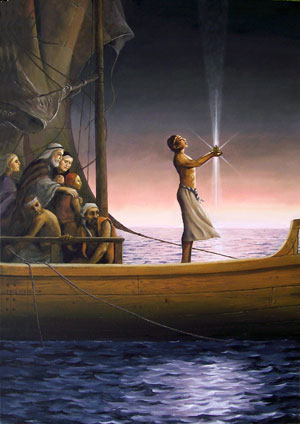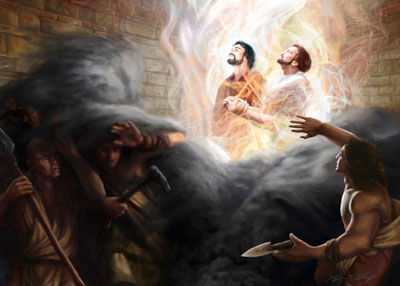
The Know
Although faith plays an important narrative and doctrinal role in many Book of Mormon stories, Ether 12 provides one of its most profound discourses on the topic, rivaled only by Alma 32. After noting Ether’s diligent efforts to preach and prophesy “great and marvelous things” unto the Jaredites, Moroni reported that “they did not believe, because they saw them not” (Ether 12:5).
Using this narrative detail as a springboard for his famous discourse, Moroni explained, “I would show unto the world that faith is things which are hoped for and not seen” (Ether 12:6, emphasis added). This strongly resembles Alma’s definition: “if ye have faith ye hope for things which are not seen, which are true” (Alma 32:21, emphasis added). Moroni concluded, “wherefore, dispute not because ye see not, for ye receive no witness until after the trial of your faith” (Ether 12:6).1
In order to demonstrate the truth of this principle, Moroni drew upon a number of episodes in the Book of Mormon. He wrote, for instance, that it was by faith that “Alma and Amulek … caused the prison to tumble to the earth,” (Ether 12:13). It was by faith that “Ammon and his brethren … wrought so great a miracle among the Lamanites” (v. 15). And it was because of the great faith of the brother of Jared that the Lord “could not withhold anything from his sight” (v. 21).2
However, instead of explicitly making the connection in each case, Moroni expected readers to recall how the characters in each story only received a witness of God’s power after their trials. For example, Alma and Amulek were literally on trial (see Alma 14:5, 18–20), made to witness the suffering of the righteous (vv. 9–14), and were thrown into prison, beaten, and deprived of food, water, and clothing (vv. 18–26). Only after suffering these depravities did the Lord deliver them by causing the prison walls to fall on their enemies.3
When it was known among the people of Zarahemla that the sons of Mosiah were going to preach unto the Lamanites, Ammon said that “they laughed us to scorn” (Alma 26:23). During the fourteen years of their ministry, Ammon recalled that their “hearts were depressed” (v. 27), they “suffered every privation” (v. 28), they were “cast out, and mocked, and spit upon, and smote upon our cheeks … stoned, and taken and bound with strong cords, and cast into prison” (v. 29). Only after suffering these trials were they able to receive the “fruits of [their missionary] labors” (v. 31).4
When the brother of Jared was concerned about journeying across the ocean in darkness, the Lord asked, “What will ye that I should do that ye may have light in your vessels?” (Ether 2:23). Rather than simply supplying the brother of Jared with a solution to his problem, the Lord required preliminary action, creativity, and then faith in the Lord’s power. Only after the brother of Jared “did molten out of a rock sixteen small stones” (Ether 3:1) and had faith to ask the Lord to cause them to shine, did he see “the finger of the Lord” (v. 6), and then was shown “all things” (Ether 3:26).5
The Why
Moroni’s discourse on faith demonstrates why the stories in the Book of Mormon are so important. It is a natural impulse to want to see or hear or feel something before accepting that it is true. The Lord reverses this inclination, requiring faith and obedience before giving empirical or miraculous confirmations of the truth. As several Book of Mormon scholars have put it, “Believing without seeing will result in greater seeing.”6 This kind of “faith—faith that is not dependent upon mortal sight—opens the spiritual eyes to greater views of the things of God.”7
D. Kelly Ogden and Andrew C. Skinner explained, “We know our mortal vision is extremely limited; there is a wide spectrum of waves and rays all around us that our eyes, incredible instruments as they are, do not see. In spiritual matters we see not with our eyes but with our spirits. Our spirit, enhanced and quickened or accelerated by the Spirit of God, can see and understand far beyond any mortal capacity.”8
It must also be recognized that the goal of faith is not simply to obtain a singular spiritual witness after the completion of a singular trial. Rather it is a process. Alma taught that faith in the word of God begins as a small seed, and that those who plant the seed in their hearts can receive an initial witness of its truth as its goodness begins to grow within them (see Alma 32:30).9 If nourished by “faith with great diligence, and with patience” (Alma 32:41), this seed will eventually “take root in you” (v. 42) and become a fully-developed “tree springing up unto everlasting life” (v. 41).10
Each step of the faith journey is filled with trials and uncertainty, yet for those who diligently and patiently exercise faith unto obedience, the Lord will provide frequent spiritual witnesses and assurances of the truth. Elder David A. Bednar taught that “the faith that fuels this ongoing process develops, evolves, and changes. As we again turn and face forward toward an uncertain future, assurance leads to action and produces evidence, which further increases assurance.” He further explained that this “helix is like a coil, and as it spirals upward it expands and widens.”11
Thus the purpose of trials and testing is far more than to provide a prerequisite to receiving answers to questions. It is to develop spiritual character—to “become what our Heavenly Father desires us to become.”12 Catherine Thomas proposed, “Faith progresses from one’s having confidence in God to God’s having confidence in that person and permitting him or her to witness and even to administer divine power, as did Moses, Alma, Amulek, Nephi and Lehi, Ammon, the three Nephite disciples, and those … like the brother of Jared … whose inner spiritual capacity was so well-developed from obedience.”13
In a world struggling with doubt and disbelief in spiritual things, the Book of Mormon stands a shining beacon of hope. Its teachings—delivered by inspired prophets—help readers understand the process of acquiring faith and to discern the evidence of its effects in their own lives. Its faith-filled stories help increase confidence that exercising faith during periods of trial and testing will eventually result in profound blessings, spiritual witnesses, and essential personal growth.
Further Reading
David A. Bednar, “Seek Learning by Faith,” Ensign, September 2007, 61–68, online at lds.org.
Robert L. Millet, “Faith,” in Book of Mormon Reference Companion, ed. Dennis L. Largey (Salt Lake City, UT: Deseret Book, 2003), 260–264.
Jeffrey R. Holland, “Rending the Veil of Unbelief,” in A Book of Mormon Treasury: Gospel Insights from General Authorities and Religious Educators (Provo, UT: Religious Studies Center, Brigham Young University, 2003), 47–66.
- 1. M. Catherine Thomas, “Trial of Faith,” in Book of Mormon Reference Companion, ed. Dennis L. Largey (Salt Lake City, UT: Deseret Book, 2003), 765, defines a trial of faith as a “period of divine testing of one’s confidence in God during which one has the opportunity to demonstrate his faith by obedience and good works, especially when faced with uncertainty, sacrifice, or adversity.”
- 2. These are only three of the many examples that Moroni provided. For his entire list see, Ether 12:7–31.
- 3. See Book of Mormon Central, “What Kind of Earthquake Caused the Prison Walls to Fall? (Alma 14:29),” KnoWhy 121 (June 14, 2016).
- 4. See Book of Mormon Central, “Why Did Ammon Borrow So Much from Tradition in Alma 26? (Alma 26:8),” KnoWhy 133 (June 30, 2016).
- 5. For a discussion of the brother of Jared and his great faith, see Jeffrey R. Holland, “Rending the Veil of Unbelief,” in A Book of Mormon Treasury: Gospel Insights from General Authorities and Religious Educators (Provo, UT: Religious Studies Center, Brigham Young University, 2003), 47–66. See also Book of Mormon Central, “Why Did Moroni Use Temple Imagery While Telling the Brother of Jared Story? (Ether 3:20),” KnoWhy 237 (November 23, 2016); Book of Mormon Central, “Where Did the Brother of Jared Get the Idea of Shining Stones? (Ether 6:3),” KnoWhy 240 (November 28, 2016).
- 6. Joseph Fielding McConkie, Robert L. Millet, and Brent L. Top, Doctrinal Commentary on the Book of Mormon, 4 vols. (Salt Lake City, UT: Bookcraft, 1992), 4:296. As an example of the superior status of a spiritual witness of truth, Elder Jeffrey R. Holland testified, “I bear witness of … restored priesthood keys which unlock the power and efficacy of saving ordinances. I am more certain that those keys have been restored and that those ordinances are once again available through The Church of Jesus Christ of Latter-day Saints than I am certain I stand before you at this pulpit and you sit before me in this conference.” See Jeffrey R. Holland, “The Cost—and Blessings—of Discipleship,” Ensign, May 2014, 8–9, online at lds.org.
- 7. McConkie, Millet, and Top, Doctrinal Commentary, 4:296.
- 8. D. Kelly Ogden and Andrew C. Skinner, Verse by Verse: The Book of Mormon, 2 vols. (Salt Lake City, UT: Deseret Book, 2011), 2:277.
- 9. For a discussion of how Alma’s explanation of developing faith correlates to creation imagery, see Book of Mormon Central, “Why Did Alma Use Creation Imagery in His Sermon on Faith? (Alma 32:40),” KnoWhy 140 (July 11, 2016).
- 10. Robert L. Millet explained that “each time a principle is applied and blessings are realized, turning faith into knowledge, faith in that principle increases. Faith can thus grow from one level to another—‘a particle of faith’ (Alma 32:27), ‘sufficient’ faith (3 Nephi 17:8), ‘much faith’ (Mosiah 27:14), ‘strong’ faith (Alma 7:17), ‘exceeding faith’ (Mosiah 4:3), ‘exceedingly great faith’ (Moroni 10:11)—into ‘perfect faith’ (2 Nephi 9:23).” See Robert L. Millet, “Faith,” in Book of Mormon Reference Companion, 262.
- 11. David A. Bednar, “Seek Learning by Faith,” Ensign, September 2007, 63, online at lds.org.
- 12. Dallin H. Oaks, “The Challenge to Become,” Ensign, November 2000, online at lds.org. In this same address, Elder Oaks further explained that “the Final Judgment is not just an evaluation of a sum total of good and evil acts—what we have done. It is an acknowledgment of the final effect of our acts and thoughts—what we have become.”
- 13. M. Catherine Thomas, “A More Excellent Way,” in Book of Mormon, Part 2: Alma 30 to Moroni, ed. Kent P. Jackson, Studies in Scripture: Volume 8 (Salt Lake City, UT: Deseret Book, 1988), 276.
Continue reading at the original source →






